Compared: 2022 Ford Bronco vs. 2022 Jeep Wrangler
These two popular off-road-ready SUVs follow a similar formula with a few key differences.
Originally published on January 19, 2022.
The Jeep Wrangler is America's most popular off-road SUV, but the new Ford Bronco puts that title in contention thanks to its all-terrain capability, eye-catching retro styling, and more modern suspension design promising better comfort.
How do these two trail-ready rides match up? Here's our tale of the tape when comparing Bronco and Wrangler.
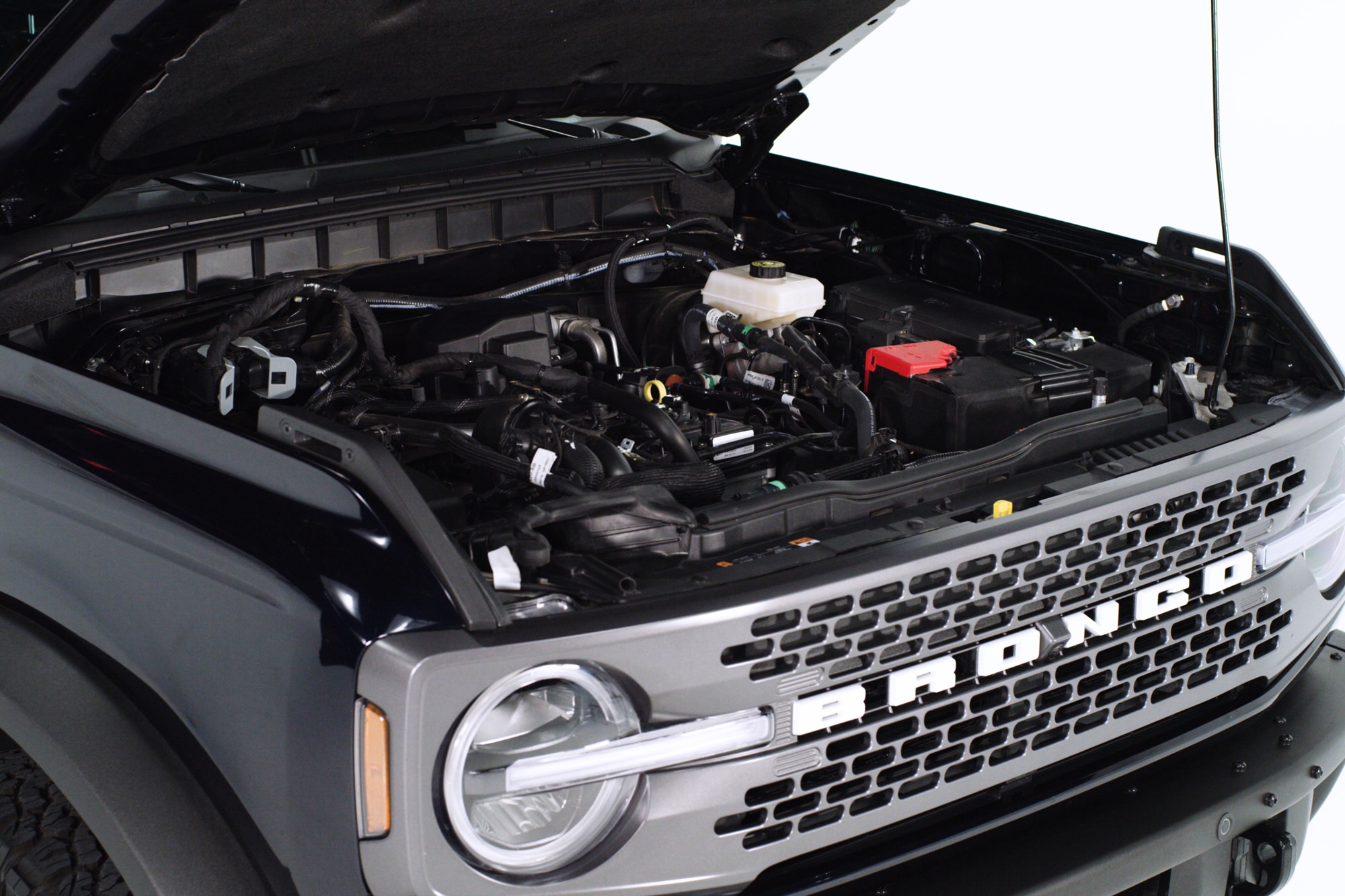 Capital One
Capital One
Engines and Fuel Economy
Of the two, the Ford Bronco has the smaller engine stable. Entry-level versions of the SUV feature a turbocharged 2.3-liter four-cylinder that's good for 300 horsepower and 325 pound-feet of torque (when using premium fuel), while an optional turbocharged 2.7-liter V-6 steps up the output to 330 horses and 415 pound-feet. The four-cylinder provides better fuel efficiency, posting 21 mpg combined regardless of whether it's matched with a seven-speed manual or 10-speed automatic transmission. The V-6, which requires the automatic, manages 19 mpg. Opting for an off-road-oriented trim level or the Sasquatch package shaves a few points from those ratings.
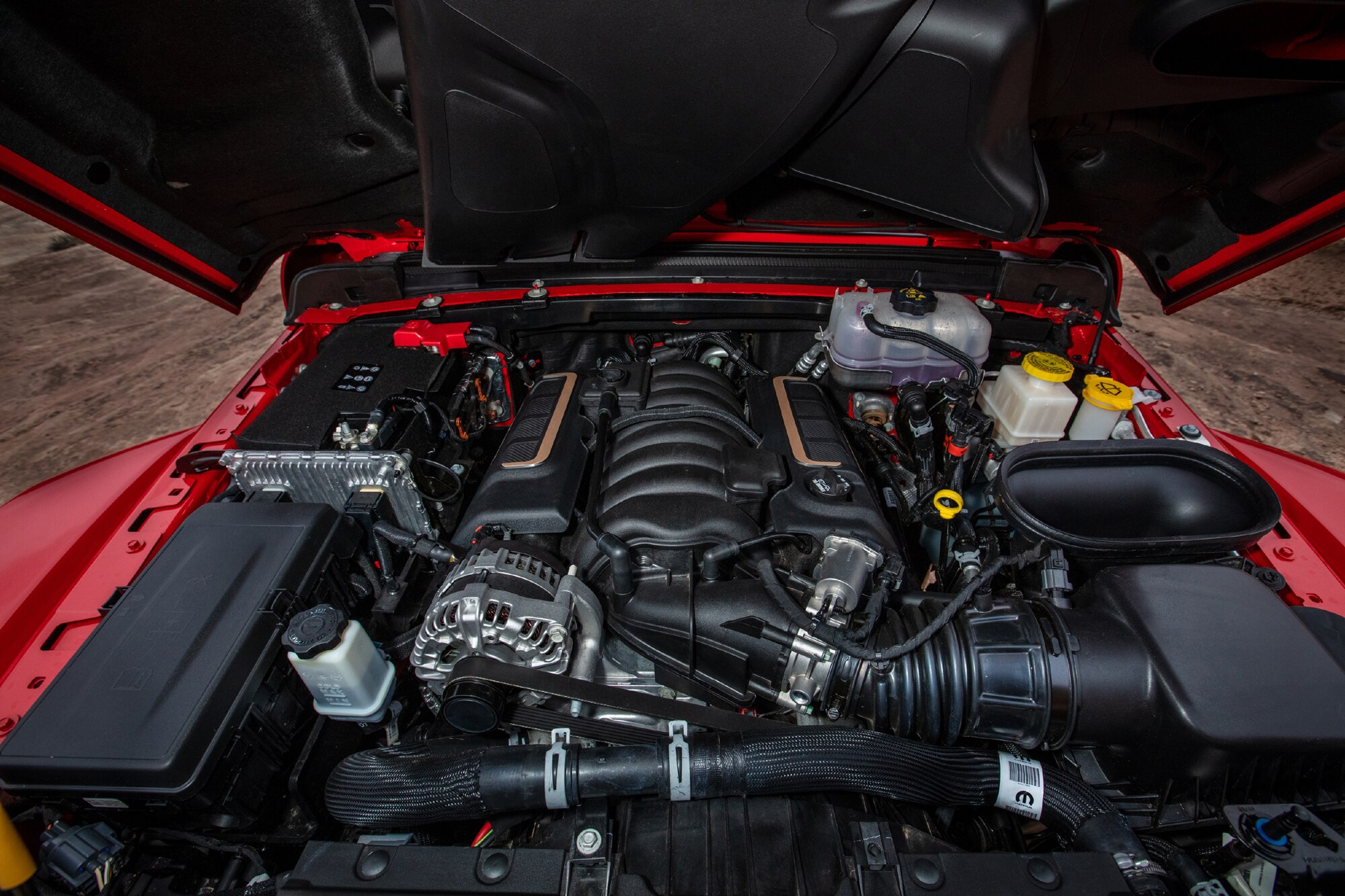 Jeep
Jeep
The Jeep Wrangler has a more extensive list of engine options. Its base 3.6-liter V-6 (with or without the eTorque 48-volt hybrid system) delivers 285 horsepower and 260 pound-feet of torque, while a turbocharged 2.0-liter four-cylinder generates 270 horses and 295 pound-feet of torque. A class-exclusive turbo-diesel V-6 (260 horsepower, 442 pound-feet) is also available, as is a 470-hp 6.4-liter V-8. Jeep offers a plug-in-hybrid powertrain for the 4xe model that allows for 22 miles of EV operation on a single charge. Transmission choices include a six-speed manual and an eight-speed automatic, depending on the engine.
The base Bronco's horsepower advantage over the staid Jeep V-6 carries the day, but as good as the Ford's turbocharged choices might be, overall the Wrangler's diverse lineup is more impressive in terms of power and efficiency. Its eTorque V-6, turbo four, turbo-diesel, and plug-in-hybrid models all beat the 2.3-liter Ford in combined mpg. And Jeep’s V-8—which manages only 14 mpg—should best any Bronco in straight-line acceleration.
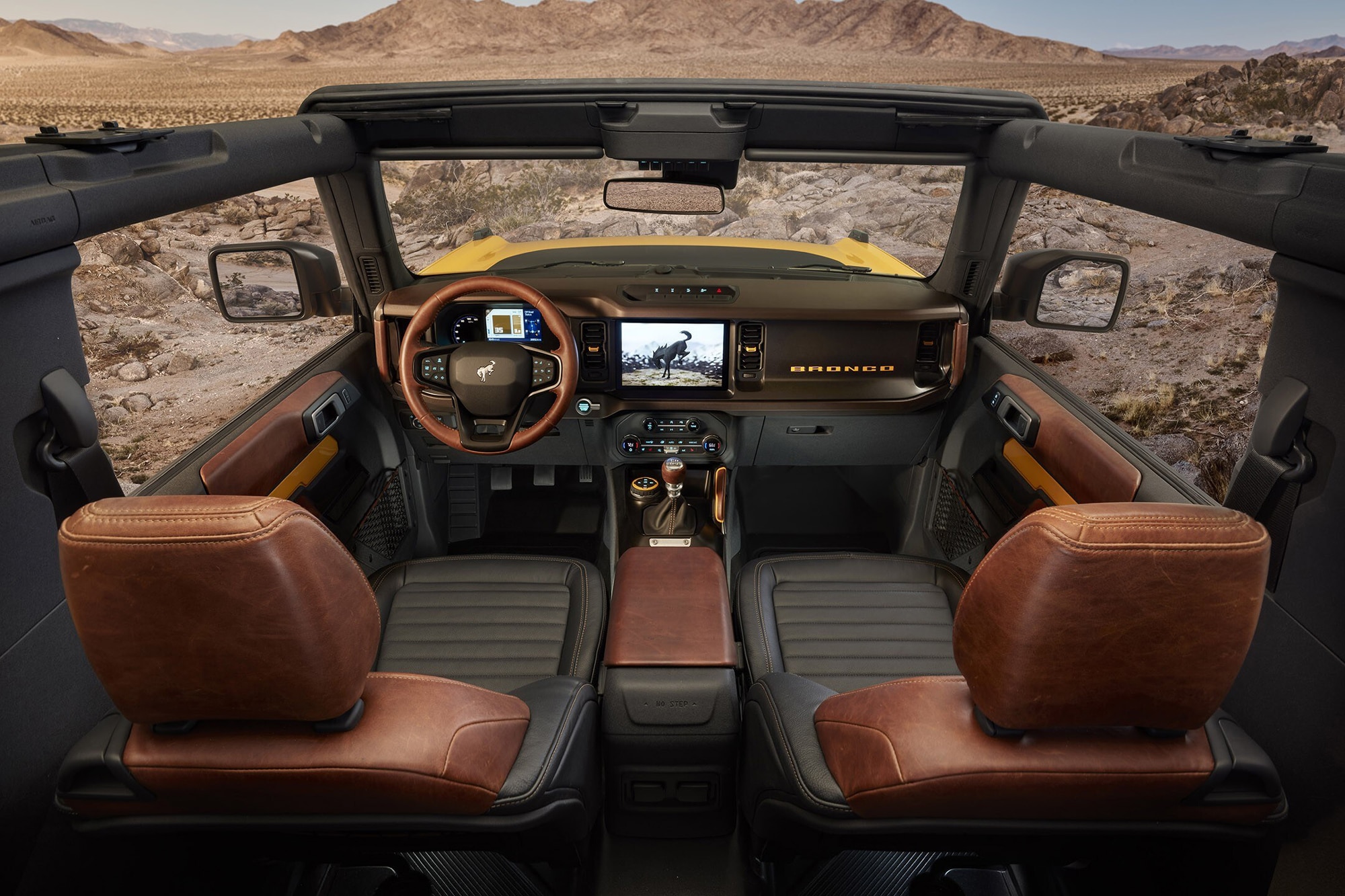 Ford
Ford
Technology and Features
Focus on the standard equipment list and the Bronco charges to the front. Ford has outfitted base versions of its SUV with advanced safety features (including forward-collision warning and automated emergency braking) through the Co-Pilot360 system, a 4G LTE Wi-Fi hotspot, Android Auto and Apple CarPlay, and LED headlights.
 Jeep
Jeep
That rises far above the entry-level Wrangler's fitments, or lack thereof: Power locks are unavailable, air conditioning is optional, and the 5.0-inch infotainment touchscreen doesn’t support smartphone mirroring. As you move up through the trim levels, the Wrangler closes the gear gap somewhat, offering packages with comparable safety features and an 8.4-inch center screen with similar capability to Ford’s 8.0-incher, but those things cost extra.
 Ford
Ford
Off-Road Capability
There are myriad trim levels and packages for both the Bronco and the Wrangler, each differing in off-road competence. On every model, the Ford SUV offers the Sasquatch package, which introduces 35-inch mud tires, unique Bilstein shocks, more aggressive gearing, and flared fenders. The lineup also showcases the Badlands (locking differentials, Bilstein shocks, front-stabilizer-bar disconnect, and a choice of oversized tires optimized for either mud or mixed terrain) and the Wildtrak (standard Sasquatch package and turbocharged V-6) as its preeminent trailblazers.
 Jeep
Jeep
Jeep is less generous with lower trim levels, but its formidable Rubicon model shoehorns in a low-range rock-crawling gear, locking Dana 44 solid axles front and rear, and a disconnecting sway bar. Standard Rubicon tires are 33 inches tall, and four-door models can add 35-inch rubber via the Xtreme Recon package, which also comes with a mild suspension lift.
Even base Broncos and Wranglers are formidable trail warriors. Both SUVs provide a choice of part-time or full-time four-wheel drive. The base Bronco's approach, break-over, and departure angles fall short of the Wrangler’s, as does its ground-clearance measurement, but spec the Sasquatch package and the Bronco can clear the same obstacles as a standard Rubicon. It's worth noting the former's mud tires are less effective than the latter’s all-terrain rubber on gravel, loose dirt, and smooth rock, which puts the Ford behind the Jeep when not digging through the muck.
It's hard to pick a clear winner here, but the good news is that buyers can configure each SUV to match the type of off-road driving they will tackle most, with the more analog Jeep favoring more experienced drivers and the Bronco welcoming beginners with its various terrain-munching drive modes.
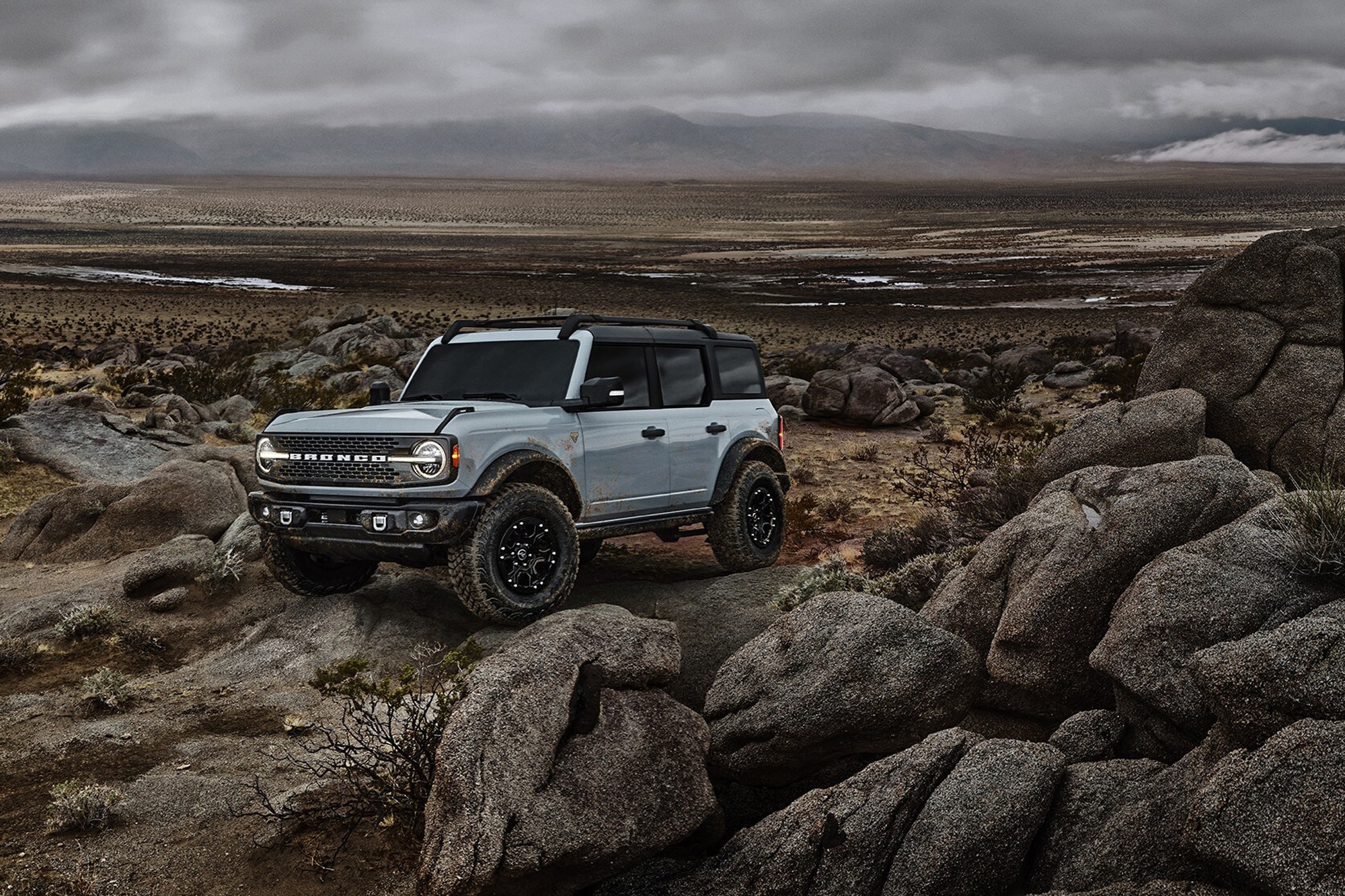 Ford
Ford
Pricing
Head to head, the two-door Ford Bronco ($30,795) and Jeep Wrangler ($30,270) are a near wash when it comes to price—until you look at the equipment list, where the Ford presents a much better value. For an extra set of doors on the entry-level models, you’ll need to tack on another $3,500 for the Jeep and $4,150 for the Ford.
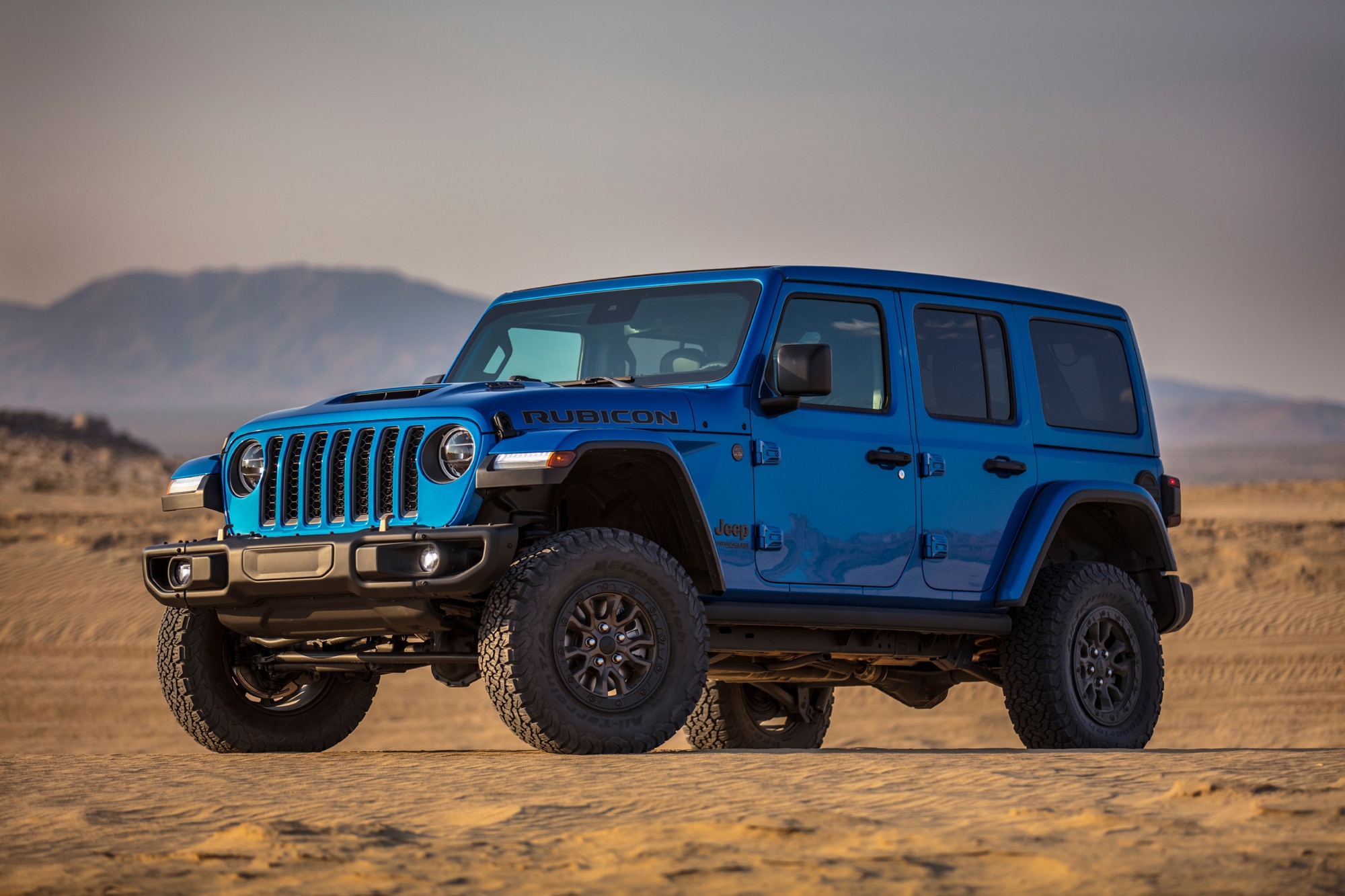 Jeep
Jeep
Jeep offers about twice the number of trim levels on the Wrangler as Ford does on the Bronco. With the First Edition trim no longer available, the four-door Wildtrak, which opens at $50,970, tops the Bronco lineup—at least until later this year, when the $69,995 Bronco Raptor will take its place. For the Wrangler, the top dog is the V-8-powered Rubicon 392, with a base price of $76,395. But the sweet spot for two-door off-road fun in either lineup hovers near the $45K mark, with the $42,095 Wrangler Rubicon and the $43,990 Bronco Badlands.
 Ford
Ford
Strengths and Weaknesses
The Wrangler's old-school chassis, which relies on a pair of solid axles, provides off-road strength and a traction advantage that's not found with the Bronco's independent front suspension setup. You'll pay for it with substantial crash and bang over potholes and occasional teetering around sharp corners, where the Wrangler feels every bit as ancient as its architecture suggests.
Good thing there's the availability of a fuel-sipping turbo-diesel engine (that vastly extends off-road range) and that both its plug-in-hybrid 4xe and V-8-powered Rubicon 392 models easily dust the Bronco in a drag race, helping owners to ignore the vehicle's often uncouth behavior and lack of basic amenities in lower trims.
 Jeep
Jeep
The Bronco's more modern suspension does it several favors in daily driving. With more precise steering than the often lazy feel of the Jeep's yoke, the Ford SUV demands less attention on longer trips at highway speeds, making it a more relaxed companion, and its independent front end means it doesn't bounce over rough stuff like the Wrangler. Its extensive equipment list also adds comfort on the way to and from the trail, making it easier to live with as a dual-purpose commuter and explorer, and its electronic driver assists extend to smoothing out off-road excursions.
Still, accessing the above means accepting the Bronco's poor mileage, which dips well into the teens on models equipped with the turbo V-6. And as with the Wrangler, you’ll have to deal with the loudness of its interior, as sound easily intrudes through either of its removable tops.
Written by humans.
Edited by humans.
 Benjamin Hunting
Benjamin HuntingBenjamin Hunting is a writer and podcast host who contributes to a number of newspapers, automotive magazines, and online publications. More than a decade into his career, he enjoys keeping the shiny side up during track days and always has one too many classic vehicle projects partially disassembled in his garage at any given time. Remember, if it's not leaking, it's probably empty.
Related articles
View more related articles